words explained
• key pound: the museum’s room where the keys for the doors to all rooms are stored. The work room of Marie-Lare’s father.
• escucheons shields
· Escutcheon (heraldry), a shield or shield-shaped emblem, displaying a coat of arms
· Escutcheon (furniture), an item that surrounds a keyhole or lock cylinder on a door
Webster gives etymology “from Vulgar Latin *scution-, scutio, from Latin scutum shield”and pronounces it like s-cushion.
• snowmelt drums, melting pieces of ice or snow, round, drum formed, snowballs, patches of snow (Webster 5)
nice: https://evaatlwcsfriendsandfamily.weebly.com/
The German translator Werner Löcher-Lawrence just avoids the word: »Autos platschen über die Straße, Schmelzwasser rinnt durch die Gossen«.
• shorts hiked up to their hips, short trousers (without long legs) sharrply pulled up as high as possible. Doerr probably didn’t want to repeat “rolled up”.
• heil Hitler – you’d spell Heil Hitler, with capital Heil (hail)
• chide, to chide, to scold someone, “no-no, you shouldn’t do that” (Webster)
• thugs with split knuckles – thug, pl. of thug, rowdy, brutal gangster (Webster).
split knuckles, brass knuckles, those metallic rings around fingers of a fist to hit in a bloody fist fight (Webster 4). Schlagring or lit. bloody fingers:
Just fake, don’t scare, no panic! Makeup … Video runs just 32"
• runnels, pl. of runnel, little water flow on a street, rivulte, streamlet (Webster), Rinnsale
• lichen, Asphodelus albus, a herbaceous perennial plant sometimes called white lichen, white asphodel, a plant on normal ground in contrast to an:
• alga, pl.algæ, living in water.
• Diplodon charuanus is expained here: p. 45: ‘Diplodon charuanus‘ is a mollusc so obscure, it has yet to make it onto the internet. Yes, these things still do exist! The sole website from an auctioneer tells us it comes from Uruguay. We do slightly better on ‘Diplodon delodontus‘.
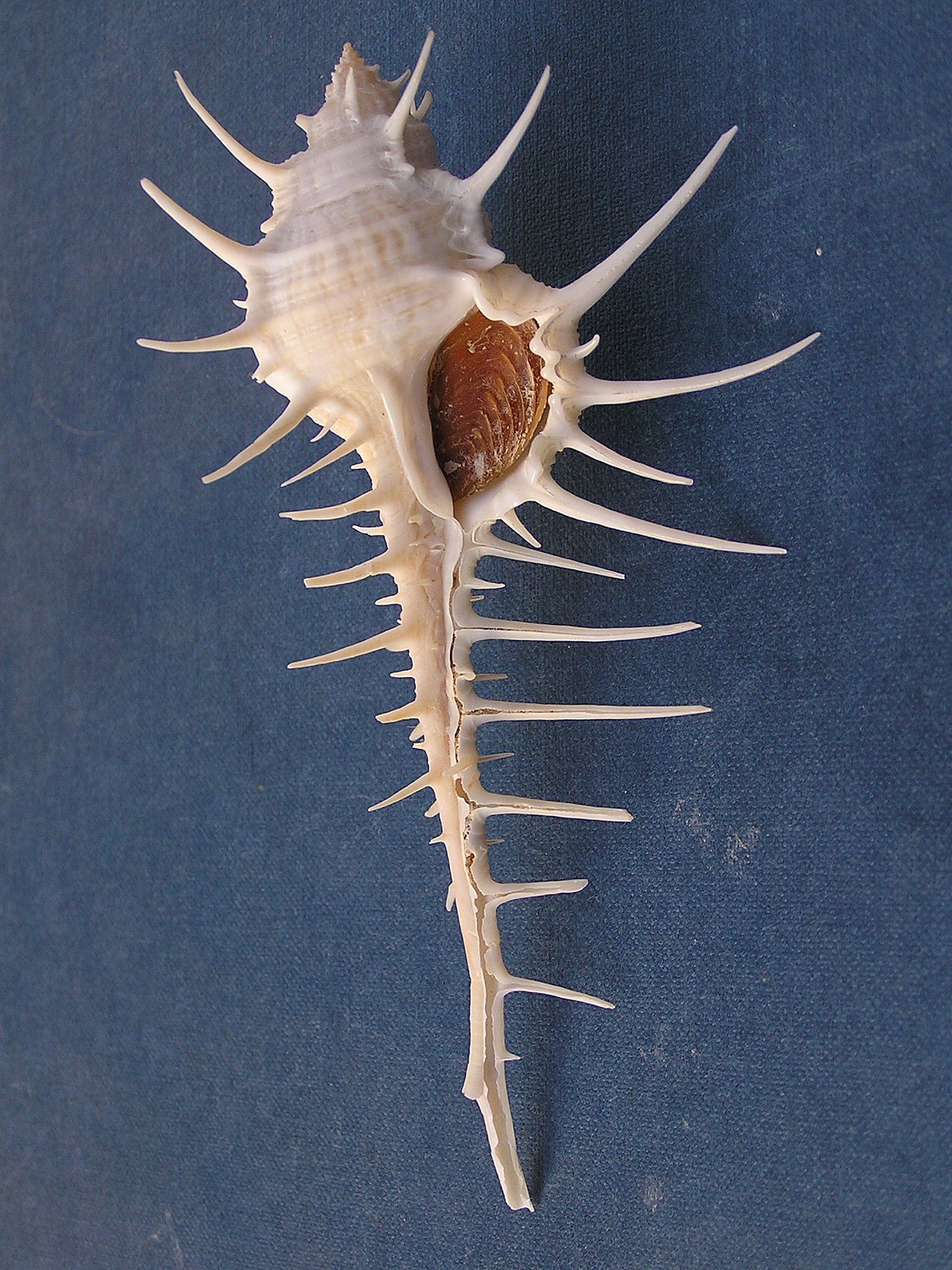 |
| Murex altispira – Wikipedia |
• twine (p 45), string (Webster), Austrian Spagat
• murex, a tropical sea snail, you’d call it a shell with spikes like needles.
Altispira must come from altus, high, many, and spira, needles, as in spiral, really locks, “round needles”.
• bantering with warders (p 55), joking with watchmen
• Congealed liver (p 59), hard, like frozen («gelato») liver. The German translator says the liver “got hard”, and that’s by
• whack the side of their wireless (p 71), knock, blow, box, (Webster); and wireless is the british word for radio. The warders whack the device ib the hope that some bad contact might bring it back to life. But the radio is ok, the transmitting stations have ceased to send signals.
• sew pearls into hems (p75), (Webster:) borders of clothing, usually turned around, like at the collar.
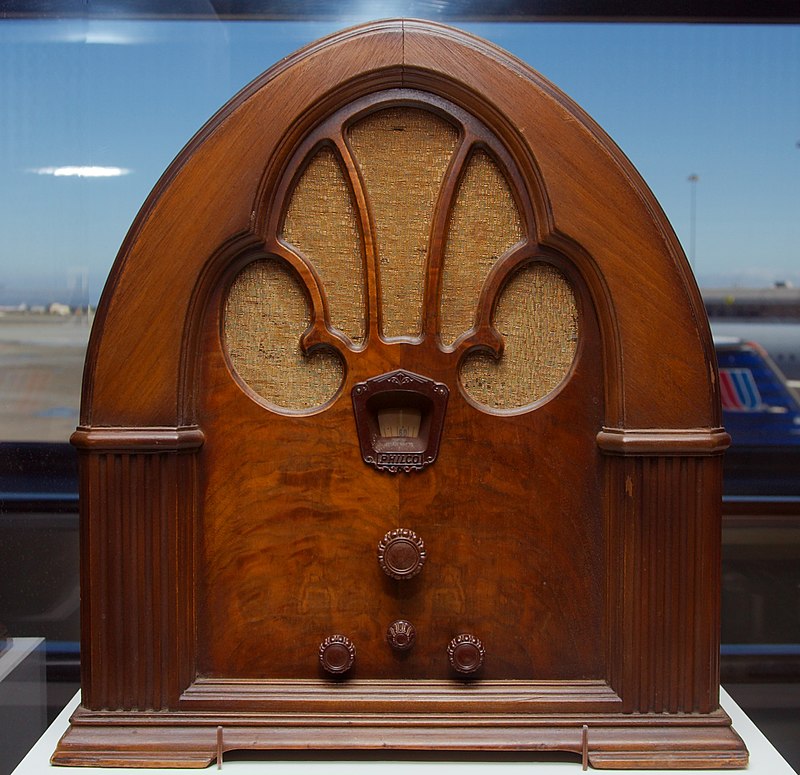 |
| Philco 90, 1931 – Wikipedia |
• give the corporal a wide berth (p 81), (Webster), stay away from, keep a distance, avoid; German »sie machten einen Bogen um«, they arced around.
• Philco (p 81), Philadelphia Storage Battery Company, making fine radios
• magnetic tuning (p 82) means that the radio uses a coil to magnetically catch the radio waves, see Popular Science of Nov. 1925, where A is the primary magnetic coil exposed to the radio waves , B the secondary magnetic coil of the tuning circuit. Actual selection of the station – tuning – is done by changing the cicuit’s capacity C.
In contrast: to use a long wire as antenna to catch the electromagnetic (!) waves would be electric tuning.
• superheterodyne (p 82) or just superhet, is a radio receiver using an intermediate frequency to process the signal.
• gadrooned moldings (p 82), carved (Webster) decorations, decorative strip
• her smooth white calves show beneath the hem of her skirt (p83). A calf, singular, is the lower part of the foot, below the knee (not young cows!), also called shin (p126) the hem of as skirt is where the dress ends and the visible body begins. Sort of minijupe.
• cream was forbidden (p 83), certainly in the First World War, in the Second?
• heron (p 85), a bird
• Heinrich Hertz’s Principles of Mechanics (p86). Now Heinrich Rudolf Hertz († 1894 in Bonn) was considered a “(half) jew” at that time. He himself had never seen himself as a Jew, and was like his converted father, a Protestant. The name Hertz, literally meaning heart, unfortunately is indicative. The Nazis wanted to rename the unit Hz (named 1933) from Hertz to Helmholtz, in vain.
The english book is from 1899, readable online here, original »Prinzipien der Mechanik in neuem Zusammenhange dargestellt« 1894 here with a foreword of Helmholtz, where he worked, – a newer reprint here. More originals to read here. About Hertz see also here (german). Hertz wanted to explain mechanics without force, but with mass, along Maxwell’s new electromagnetic vawe theory. In 1884 Hertz is the first to induce an electromagnetic wave. He found out light to be radio waves. – (Geadelt wurde dieser Hertz nicht, Helmholtz schon.)
• “Yes, Frau?” (p 86). English authors and speakers will never learn that Germans never address a person with Herr oder Frau, formely even as Fräulein (miss), just as an Englishman would never say “Yes, woman”. You’d always add the name, »Frau Jörn«, or say “dear friend” or something like that.
• solenoid (p 68), an electrical coil
• Vaucresson (p 87)
• field light (p 98), the German translator just says: lamp, I’d say: flashlight, probably sturdy and strong. Here you see “a proper tactical field light”. Field is both an agricultural area and a battlefield.
• estuary (p100) is where a river flows into the sea (Wikipedia, Webster).
• banister (p 101) or baluster or even a whole, long balustrade. Webster defines it clearly: a handrail with its supporting posts.
• coatrack (p 101) is not some mysterious co-attraction, but a coat-rack to hang your overcoats.
• crockery (p 101) is tableware, all the dishes (china) and forks and spoons etc. (cutlery) you put on a table before serving. Here Marie-Laure means breakable dishes from …
• … the hutch (p 101) is American (Wikipedia), a cupboard (Webster).
• welter (p 101) is a turmoil (Webster), a big confusion, a chaos.
• thronged (p 107), full, full (Webster)
• sash windows (p 109) are windows with frames, Webster to sash: the framework in which panes of glass are set in a window or door. “Installing little windows” would have been fine, I think. But modern bestseller authors challenge the reader.
• seethe (p 109) (Webster), stand in stale water, I’d say
•The padlock is a brand-new single-latch Burguet (p 110). A padlock is a lock to externally hang into two rings, (Webster:) “a removable lock with a shackle that can be passed through a staple or link and then secured”. A latch is anything to fasten a door, see here. Single means, I guess, that the gate had only one lock, see here. See some old models here. The Burguet brand I couldn’t find, maybe for guitars, or castles (= germ. Schlösser, same as locks)
(D:»Das Vorhängeschloss ist ein neues, einfaches Burguet-Schloss.«)
• spigot (p 110), that’s where water comes out (Webster), a faucet.
• Essen, eighteen miles south of Zollverein (p 112). Essen (lit. eat) is the main city in the industrial Ruhr area, Zollverein a northern part of it, some few kilometers from the center. Zollverein literally means customs club, to confuse foreigners? University Essen (»Universität Gesamthochschule Essen«): »Der Name Zollverein lehnt sich an die von den deutschen Kleinstaaten auf zwischenstaatlicher Ebene gebildeten Zollvereinigungen an, deren Ziel es war, durch allgemeingültige Maße und Gewichte den Handel zwischen den Staaten zu erleichtern« – The name really stems from an agreement between small German states to use the same measures, easing trade.
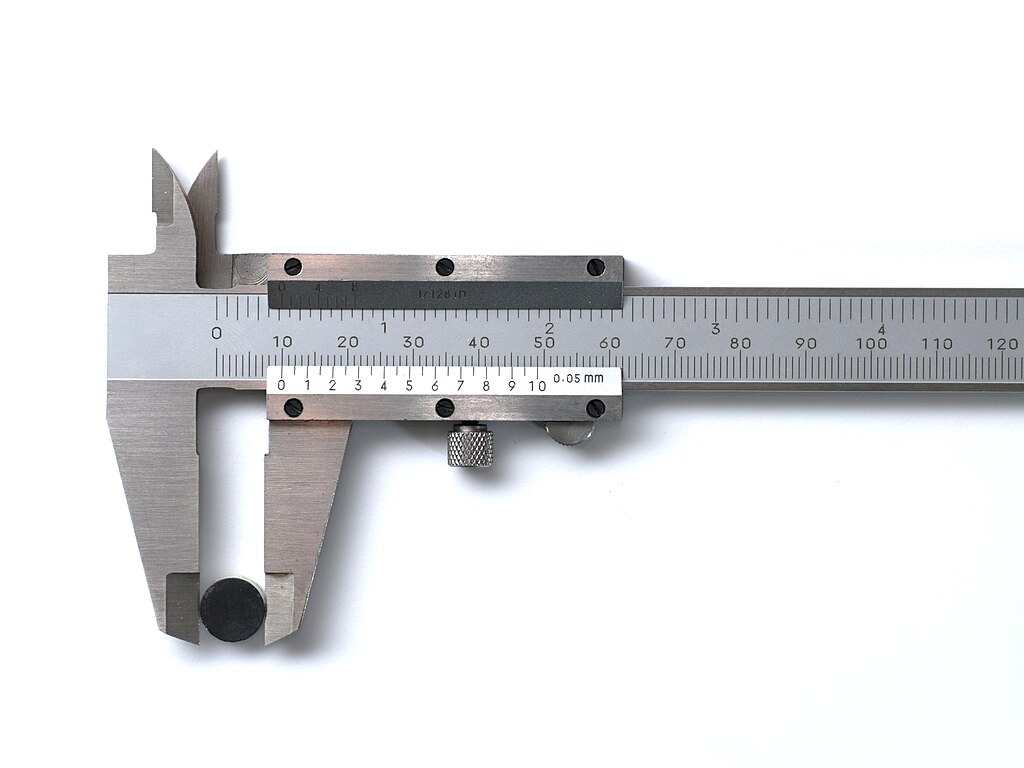 |
| Calipers – Photo Eugster, Wikipedia |
• protractor (p 114), a semicircle scale to measure angles (degrees), is found along with school childen’s pencils and pens, in Wikipedia here.
• portcullis (p 118), a heary sliding door or gate (Wikipedia)
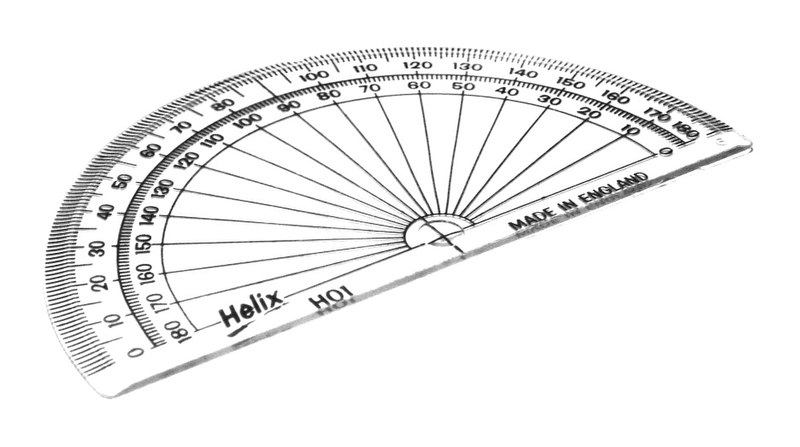 |
| Protractor – Photo Cephyris, Wikipedia |
• steeple above rooftops (p 118), see Wikipedia, is a little decorative tower growing out of the roof, rather than standing on grond. Both towers and steeples may gave a spire on top (German Helm, helmet).
• Two dead bolts, one chain (p 120). Deadbolts are separate, “dead” locks, up or below the classic opening door handle and doorlock, see Wikipedia. A chain – if used cautiously – let you open the door just a bit before allowing someone in. Wikipedia show even a door chain.
• to scoot (p 120) means to slide quickly, especially while seated (Webster). Like if a full glass topples.
• peaches in cans? (p 121) In the war? Madame Manec: “I make them every year.” Well, canning maybe was done in households into tin cans, as we know them today, but probably mostly into glasses. Wikipedia: “In 1809, Nicolas Appert, a French confectioner and brewer, observed that food cooked inside a jar did not spoil unless the seals leaked, and developed a method of sealing food in glass jars.” Weck jars were invented in 1895 here in Bonn. The German translator thinks so as well, and writes »Einmachglas«.
• wedges (p 121) – Well, Marie-Laure does not eat some hard wedges, wooden or metal boardlike pieces with a slim and a broader side to stop doors from closing or to splinter firewood, she enjoys slices (same form as wedges) of fruit. “Pieces” says the translator, “of sunshine”, boring. Sunny peaches.
• grown-ups are mouthing (p 121), they “mouth”, speak (Webster “always mouthing platitudes”). Why Doerr uses this rare, possibly derogative word here, is beyond me. I pledge for simple words for simple facts. So better: I prefer simple words for simple facts: “Grown-ups speak more to each other.”
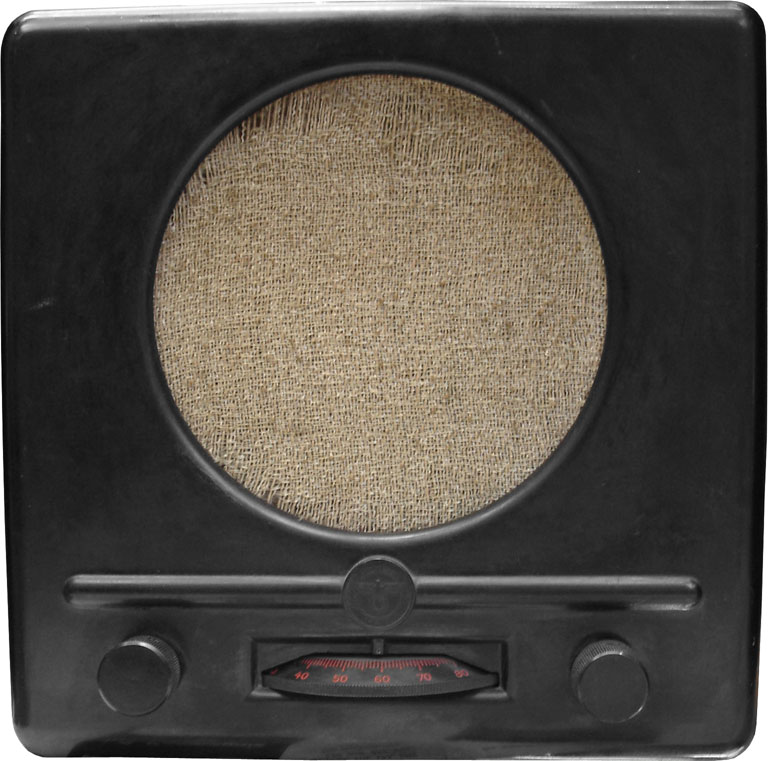 | ||
| Volksempfänger DKE 38 w/o feedback amplification, LW and MW on a cont. scale. Design Walter Maria Kersting. |
• Deutschlandsender (p 123) 182 kHz LW from Königs Wusterhausen [sic!]
• Rise! Rise! All glory to the fatherland! (p 125) – even the German translator didn’t find the orignal …
• bash her shins (p 126), have her feet hit something, see calves p83.
• flaps the quilt (p 126), airs the bed covers, I’d say.
• vermilion (p131) is a color: very red. I think red flags came with socialism, communism, unions, but not with Nazis who preferred white with swasticas.
 |
| Common Whelp Buccinum undatum Wikip. |
• whelk (p 134), marine snail, see picture
• davenport (p 135) Webster: a small compact writing desk or a large upholstered sofa often convertible into a be. = Devonport
–––––––––––––––––––––––––––––
• Explanations and thoughts up to page fifty. Then the anonymous reader quit …
https://notesfromtheether.wordpress.com/2016/10/
• Original English version at
• German version of the book at
https://kindergeschichten.files.wordpress.com/2017/07/alles-licht_-das-wir-nicht-sehen_-_doerr_-anthony-roman-_2014.pdf (Deutsch von Werner Löcher-Lawrence)
https://www.randomhouse.de/leseprobe/Alles-Licht-das-wir-nicht-sehen/leseprobe_9783442749850.pdf
• Spanish: La Luz Que No Puedes Ver https://readofcopy.com/lib/-la-luz-que-no-puedes-ver-spanish-edition.pdf?web=etl.dose.com (you must register).
https://mseffie.com/assignments/all_the_light/all_the_light.html
• Webster explains diacritic signs
Link to this blog entry http://j.mp/2UTTfBc
= https://blogabissl.blogspot.com/2019/03/all-light-we-cannot-see-words.html
Keine Kommentare:
Kommentar veröffentlichen